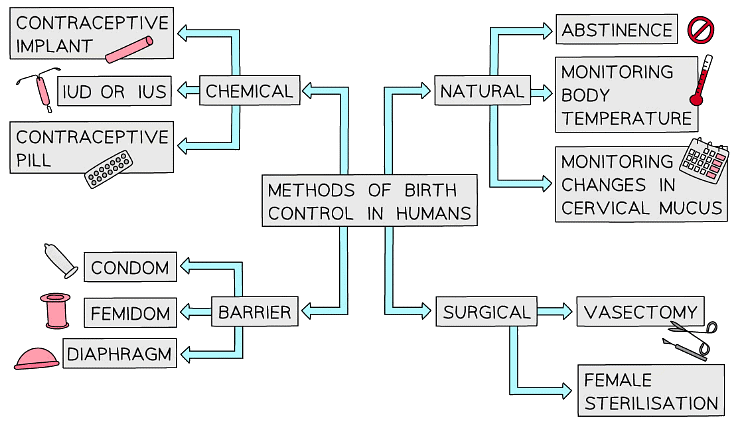Contraception | Biology for Grade 10 PDF Download
| Table of contents |

|
| Control of Fertility |

|
| Types of Contraception |

|
| Chemical |

|
| Barrier |

|
| Natural |

|
| Surgical |

|
| Hormonal methods of contraception |

|
Control of Fertility
- Fertility can be controlled by a variety of hormonal and non-hormonal methods
- Contraceptive methods aim to prevent fertilisation and pregnancy, and include the use of hormones (oestrogen and progesterone) as well as non-hormonal methods (such as the use of barriers or surgery)
- Hormones can also be used to increase the chance of pregnancy occurring when it previously might not have done
- Explain everyday and technological applications of science; evaluate associated personal, social, economic and environmental implications; and make decisions based on the evaluation of evidence and arguments
Exam Tip: The use of hormones to control fertility is a pretty common exam question where you may be asked to evaluate the different methods of contraception and to consider the benefits or problems associated with them.Benefits of contraception include preventing unwanted pregnancies or pregnancies that may lead to risks to the mother’s health or pregnancies that have occurred as a result of rape. The counter-arguments involve ethical and religious concerns about making decisions that may or may not lead to life.Issues around contraception cannot be answered by science alone – it’s important to remember that.
Types of Contraception
 There are many different types of contraception but not everyone may have access to them
There are many different types of contraception but not everyone may have access to them
- Contraceptive methods are important in keeping family sizes small and in limiting the increase in human population
- Humans can use barrier, chemical, surgical and natural contraceptive methods to prevent a pregnancy
- Some birth control methods also give protection from sexually transmitted infections
Chemical
- Oral contraceptives that contain hormones to inhibit FSH production so that no eggs mature; there are two types:
- The combined pill contains oestrogen and progesterone which is over 99% effective at preventing pregnancy
- High levels of oestrogen inhibit FSH production preventing the maturation and release of eggs
- Progesterone also plays a role in inhibiting the release of mature eggs and stimulates the production of a thick mucus which prevents sperm from reaching any eggs that are released
- There is also the progesterone-only pill which has fewer side effects
- Injection, implant or skin patch of slow-release progesterone to inhibit the maturation and release of eggs for a number of months or years
- Benefits of implants reduce the chance of someone forgetting to take the pill (which should be taken at the same time every day to be most effective)
- Intrauterine devices (IUD) which prevent the implantation of an embryo or release a hormone; there are two types
- A plastic IUD produces progesterone which stimulates the production of a thick mucus lining preventing sperm from reaching any eggs
- A copper IUD works by releasing low levels of copper ions which disable sperm cells
Barrier
- Barrier methods such as condoms and diaphragms prevent the sperm from reaching an egg
- Condoms are the only barrier method that can prevent the spread of sexually transmitted infections
- Spermicidal agents which kill or disable sperm – these are only 70 - 80% effective
Natural
- Abstaining from intercourse when an egg may be in the oviduct
- Complete abstinence is the only 100% effective method at preventing pregnancy
- Natural methods involve avoiding intercourse during the most fertile part of the menstrual cycle but they are not highly effective as fertility cannot be accurately predicted
Surgical
- Surgical methods of male and female sterilisation
- In a female, the oviducts which connect the ovaries to the uterus (also called the fallopian tubes) can be cut and tied
- In a male, the sperm ducts (the tube connecting the testes to the penis) can also be cut and tied in a procedure called a vasectomy
- Both methods are highly effective but there have been a small number of cases where tubes have rejoined
Hormonal methods of contraception
Oral contraceptives
Human fertility is controlled by hormones, so fertility can be controlled using hormonal forms of contraception.

The oral contraceptive, which is known as the pill, contains oestrogen or progesterone. These hormones inhibit the production of FSH, and eggs cannot mature.
Benefits and risks
- Oral contraceptives are more than 99% effective if taken correctly and can reduce the risk of certain cancers.
- However, there are possible side effects, such as changes in weight, mood and blood pressure due to high levels of oestrogen. Modern pills contain much less oestrogen.
- Contraceptive injections, implants or skin patches contain slow release progesterone to inhibit the maturation and release of eggs.
|
102 videos|93 docs|13 tests
|















